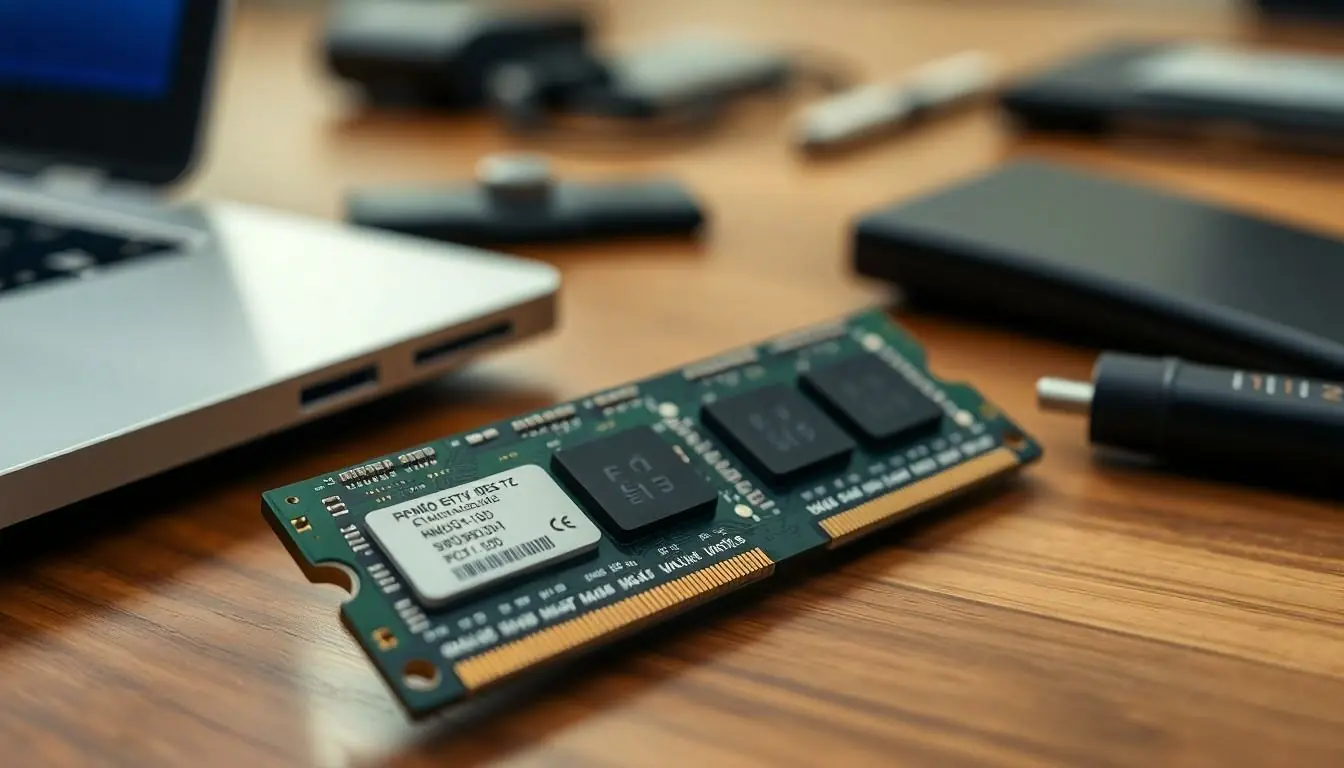In the world of laptops, memory modules are the unsung heroes, quietly powering everything from your Netflix binge to that intense gaming session. But not all memory modules are created equal. When it comes to laptops, one form factor reigns supreme, and it’s time to uncover this champion of compact computing.
Table of Contents
ToggleOverview of Memory Module Form Factors
Memory modules for laptops vary in design and size. The most prevalent form factor is SO-DIMM (Small Outline Dual In-line Memory Module), commonly used due to its compact form. SO-DIMMs fit snugly in laptops, allowing manufacturers to maximize space while maintaining performance.
Different generations of SO-DIMM exist, with DDR4 and DDR5 being the latest. DDR4 SO-DIMMs support data rates reaching 2133 MT/s to 3200 MT/s, while DDR5 modules can exceed 4800 MT/s. Users should consider these specifications when choosing upgrades for better performance.
Other form factors like MicroDIMM and LGA (Land Grid Array) might exist but are less common. MicroDIMM targets ultra-compact devices, yet it remains rare due to limited manufacturing. LGA modules, on the other hand, are more frequently found in desktops rather than laptops.
Selecting the right memory module involves understanding compatibility. Laptop models dictate which form factors are suitable. Checking manufacturer specifications and user manuals ensures users choose the appropriate SO-DIMM variant.
Recognizing the significance of memory module form factors helps in making informed decisions. Upgrading to a higher capacity or faster module can enhance the laptop’s overall performance for tasks like gaming or streaming. Prioritizing these factors ensures the best use of limited internal space while achieving desired speed and efficiency in laptops.
Common Memory Module Types

Many laptop memory modules prioritize compactness without sacrificing performance. The most common form factor used in laptops is the SO-DIMM.
SO-DIMM Explained
SO-DIMM, or Small Outline Dual In-line Memory Module, provides a space-efficient solution for laptops. Its compact design accommodates tighter spaces within portable devices. Typically, it measures 67.6 mm in length, allowing it to fit smoothly into laptop cases. SO-DIMMs support various memory types, notably DDR4 and DDR5, giving users options for different performance needs. Data rates for DDR4 can range from 2133 MT/s to 3200 MT/s, while DDR5 offers speeds exceeding 4800 MT/s. This range of specifications ensures ample bandwidth for tasks like gaming or multitasking.
DIMM vs. SO-DIMM
DIMMs, or Dual In-line Memory Modules, mainly serve desktops and larger systems. Their length of 133.35 mm allows for greater memory capacity but occupies more space. SO-DIMMs differ by providing a smaller footprint. Designed for laptops, its size meets strict spatial requirements without compromising functionality. Desktop systems typically utilize DIMMs that have higher performance specifications but lack portability. Compatibility issues can arise if one attempts to interchange DIMMs with SO-DIMMs due to their different designs and configurations. Understanding these distinctions helps users select the appropriate memory module for their devices.
Factors Influencing Memory Module Choices
Several factors influence the choice of memory modules for laptops, primarily size and performance. Understanding these aspects helps users select optimal components for their devices.
Size and Compatibility
Size significantly affects compatibility with laptop designs. SO-DIMMs are favored for their compact form, fitting snugly within limited internal spaces. Laptop manufacturers often design units around the SO-DIMM standard, ensuring easy installation and effective performance. Not every laptop supports all memory types; thus, checking the laptop’s specifications remains essential. Searching for compatible modules ensures users avoid mismatches, allowing smooth upgrades or replacements. Manufacturers frequently list compatible memory configurations in user manuals or online resources, simplifying the selection process.
Performance Considerations
Performance considerations focus on data transfer rates and overall efficiency. DDR4 SO-DIMMs typically range from 2133 MT/s to 3200 MT/s, while DDR5 boasts speeds above 4800 MT/s. Higher data rates enhance multitasking capabilities, making the laptop more responsive during intensive tasks. Memory latency also plays a role; lower latency improves performance, particularly in gaming or resource-heavy applications. Users should assess their specific needs, moving towards faster RAM types if they engage in demanding tasks. Ultimately, matching performance needs with the right memory module can lead to noticeable improvements in overall system responsiveness.
Trends in Laptop Memory Modules
The landscape of laptop memory modules continually shifts to address user needs and technological advancements. One notable trend involves smaller, more efficient designs.
Evolution of Form Factors
Form factors like SO-DIMM have evolved significantly to accommodate changing demands. SO-DIMM first entered the market as laptops began to prioritize portability without sacrificing performance. New generations, including DDR4 and DDR5, have expanded data transfer rates, enhancing overall efficiency. DDR4 supports 2133 MT/s to 3200 MT/s, while DDR5 exceeds 4800 MT/s, showcasing a commitment to speed enhancement. Manufacturers also explore lighter materials and innovations that further compress designs, enabling these modules to fit seamlessly into laptops. Overall, this evolution reflects a steadfast focus on maximizing performance within compact spaces.
Future Predictions
Manufacturers anticipate continued advancements in laptop memory form factors. The shift toward increasing data rates and efficiency remains strong, aligning with the growing demands of high-performance applications. DDR6 is already in discussions, promising even higher data rates and enhanced performance. Innovations in energy efficiency also drive future designs, as users seek eco-friendly, high-performance solutions. Integration of AI technologies may play a role in optimizing memory management, further enhancing responsiveness. Trends suggest a combination of form factor sophistication and performance adaptability, catering to future laptop users’ needs, such as intensive gaming and multitasking.
Choosing the right memory module is essential for optimizing laptop performance. SO-DIMM stands out as the most common form factor due to its compact design and impressive capabilities. As technology evolves users can expect even more efficient and powerful memory solutions in the future. Staying informed about specifications and compatibility ensures that users can make the best choices for their devices. With advancements on the horizon the landscape of laptop memory is set to become even more exciting.